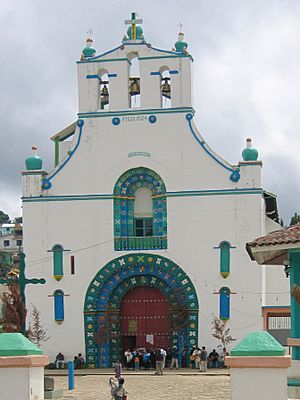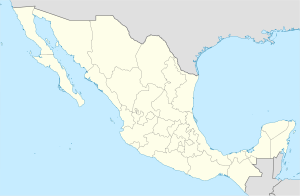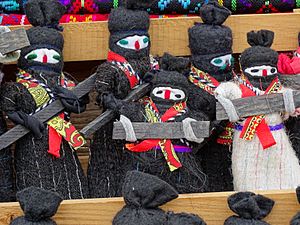Chamula facts for kids
Quick facts for kids
Chamula
|
|
|---|---|

Templo de San Juan Chamula
|
|
 |
|
| Country | |
| State | Chiapas |
| Population
(2010)
|
|
| • Total | 76,941 |
San Juan Chamula is a special area and town in the Mexican state of Chiapas. It is located about 2.9 kilometers (1.8 miles) from San Cristóbal de las Casas. In 2010, the total population of this area was 76,941 people. Almost everyone living here is indigenous and speaks their own language. In fact, 99.5% of people aged 3 or older speak an indigenous language. The Tzotzil people and their language are the most common in San Juan Chamula.
Contents
Exploring San Juan Chamula
Where is Chamula?
Chamula is found in the Chiapas highlands, which are high up in the mountains. It sits at an altitude of about 2,200 meters (7,200 feet). The area is home to the Tzotzil Maya people, who are an indigenous group. Their language, Tzotzil, is one of the Mayan languages.
Chamula's Special Status
The town of Chamula has a unique independent status within Mexico. This means that outside police or military forces are not allowed in the village. Chamula has its own local police force to keep things safe and orderly.
People and Communities
As of 2010, the main town of Chamula had a population of 3,329 people. Besides the main town, the Chamula area includes 149 smaller communities. Some of the larger ones in 2010 were Cruztón (1,756 people), Yaltem (1,664), Chicumtantic (1,599), and Nichnamtic (1,496). These smaller communities are mostly rural.
What to See in Chamula
The church of San Juan is in the main town. Inside, it is filled with bright, colorful candles and smoke from burning copal resin incense. This incense is often used in ceremonies across southern Mexico. Along the church walls, you'll see statues of Catholic saints. However, for the local people, these saints also represent ancient Mayan gods. People light candles and sit on the floor to pray below these saints. The way Catholicism is practiced here is a mix of old Maya traditions, Spanish Catholic customs, and newer ideas.
There are no benches or pews in the church. The entire floor is covered with fresh green pine branches. Local traditional healers help people with health problems or other issues. They might suggest remedies like candles of certain colors, special flower petals, or feathers. For very serious problems, they might even suggest a live chicken. These items are then used in a healing ceremony. Chamula families kneel on the church floor with their special items, stick candles to the floor with melted wax, and drink a traditional ceremonial drink called Posh. They also chant prayers in an old form of the Tzotzil language.
It is very important to know that taking photos inside the church is strictly forbidden. You are also not allowed to photograph the Christmas procession to the church. If visitors break this rule, they might be asked to leave the town.
Local Life and Crafts
The main crops grown in Chamula are corn, beans, and squashes.
Women in Chamula often create traditional clothing, warm blankets, and souvenirs. These souvenirs sometimes include items related to the Zapatista movement, like pens with small clay figures of famous Zapatista leaders such as Subcomandante Marcos.
See also
 In Spanish: San Juan Chamula para niños
In Spanish: San Juan Chamula para niños



